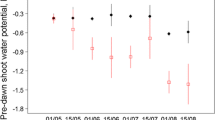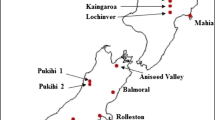Abstract
Quantitative genetic diversity is a fundamental component of the interaction between natural populations and their environment. In breeding programmes, quantitative genetic studies on tropical trees have so far focused on fast-growing, light-demanding species, but no information exists on shade-tolerant, slow-growing species. For this study, 27 3-year-old open-pollinated families of the Neotropical shade-tolerant rainforest tree Sextonia rubra were measured in semicontrolled conditions for 20 morphological, growth, and photosynthesis traits; the effect of genetic relatedness, habitat of provenance, and mother tree status on seedling traits was analysed. Nine traits displayed significant genetic effects, while mother tree status and habitat effects were not significant (P > 0.05) for an y trait. Estimated heritability varied between 0.14 and 0.28, with growth-related traits having the highest values. Additive genetic variation correlated positively with nonheritable variation, suggesting that ecological–evolutionary factors increasing or decreasing additive genetic variance may also affect nonheritable variation in the same direction. Our results suggest that quantitative genetic variability should be taken into account in ecological studies on, and in the management of, natural tropical rainforests; further research is needed to investigate genetic × environment interactions, in particular from the point of view of the genetic response of shade-tolerant plant species to variations in light availability.

Similar content being viewed by others
References
Augspurger CK, Kitajima K (1992) Experimental studies of seedling recruitment from contrasting seed distributions. Ecology 73:1270–1284
Balloux F, Amos W, Coulson T (2004) Does heterozygosity estimate inbreeding in real populations? Mol Ecol 13:3021–3031
Baraloto C, Goldberg D, Bonal D (2005) Performance trade-offs among tropical tree seedlings in contrasting microhabitats. Ecology 86:2461–2472
Baraloto C, Bonal D, Goldberg D (2006) Differential seedling growth response to soil resource availability among nine Neotropical tree species. J Trop Ecol 22:487–497
Barigah TS, Imbert P, Huc R (1998) Growth and net assimilation rate of seedlings of ten Guianan tree species grown under five light regimes. Ann For Sci 55:681–706
Bonal D, Born C, Brechet C et al (2007) The successional status of tropical rainforest tree species is associated with differences in leaf carbon isotope discrimination and functional traits. Ann For Sci 64:169–176
Bouffier L, Raffin A, Kremer A (2008) Evolution of genetic variation for selected traits in successive breeding populations of maritime pine. Heredity 101:156–165
Brendel O, Le Thiec D, Scotti-Saintagne C et al (2008) Quantitative trait loci controlling water use efficiency and related traits in Quercus robur L. Tree Genet Genom 4:263–278
Bundock P, Potts B, Vaillancourt R (2008) Detection and stability of quantitative trait loci (QTL) in Eucalyptus globulus. Tree Genet Genom 4:85–95
Callister A, Collins S (2008) Genetic parameter estimates in a clonally replicated progeny test of teak (Tectona grandis Linn. f.). Tree Genet Genom 4:237–245
Carnegie A, Johnson I, Henson M (2004) Variation among provenances and families of blackbutt (Eucalyptus pilularis) in early growth and susceptibility to damage from leaf spot fungi. Can J For Res 34:2314–2326
Cornelius J (1994) Heritabilities and additive genetic coefficients of variation in forest trees. Can J For Res 24:372–379
Costa e Silva J, Dutkowski G, Borralho N (2005) Across-site heterogeneity of genetic and environmental variances in the genetic evaluation of Eucalyptus globulus trials for height growth. Ann For Sci 62:183–191
Coste S, Roggy J-C, Imbert P et al (2005) Leaf photosynthetic traits of 14 tropical rain forest species in relation to leaf nitrogen concentration and shade tolerance. Tree Physiol 25:1127–1137
Favrichon V (1994) Classification des espèces arborées en groupes fonctionnels en vue de la réalisation d’un modèle de dynamique de peuplement en forêt Guyanaise. Revue écologique (Terre et Vie) 49:379–403
Hansson B, Westerberg L (2002) On the correlation between heterozygosity and fitness in natural populations. Mol Ecol 11:2467–2474
Hardy OJ, Maggia L, Bandou E et al (2006) Fine-scale genetic structure and gene dispersal inferences in 10 Neotropical tree species. Mol Ecol 15:559–571
Hodge G, Dvorak W, Urueña H et al (2002) Growth, provenance effects and genetic variation of Bombacopsis quinata in field tests in Venezuela and Colombia. For Ecol Manag 158:273–289
Hodge GR, Volker PW, Potts BM et al (1996) A comparison of genetic information from open-pollinated and control-pollinated progeny tests in two Eucalyptus species. Theor Appl Genet 92:53–63
Kormanik P, Sung S, Kormanik T et al (1998) Effect of acorn size on development of northern red oak 1–0 seedlings. Can J For Res 28:1805–1813
Lynch M, Walsh B (1998) Genetics and analysis of quantitative traits. Sinauer, Sunderland, MA
Navarro C, Montagnini F, Hernández G (2004) Genetic variability of Cedrela odorata Linnaeus: results of early performance of provenances and families from Mesoamerica grown in association with coffee. For Ecol Manag 192:217–227
Poorter L, Markesteijn L (2008) Seedling traits determine drought tolerance of tropical tree species. Biotropica 40:321–331
Potts B, Jordan G (1994) Genetic variation in the juvenile leaf morphology of Eucalyptus globulus Labill. ssp. globulus. For Genet 1:81–95
Rae A, Pinel M, Bastien C et al (2008) QTL for yield in bioenergy Populus: identifying G × E interactions from growth at three contrasting sites. Tree Genet Genom 4:97–112
Santiago LS, Wright SJ (2007) Leaf functional traits of tropical forest plants in relation to growth form. Funct Ecol 21:19–27
Scotti-Saintagne C, Bodénès C, Barreneche T et al (2004) Detection of quantitative trait loci controlling bud burst and height growth in Quercus robur L. Theor Appl Genet 109:1648–1659
Sotelo Montes C, Beaulieu J, Hernández RE (2007) Genetic variation in wood shrinkage and its correlations with tree growth and wood density of Calycophyllum spruceanum at an early age in the Peruvian Amazon. Can J For Res 37:966–976
Sterck FJ, Poorter L, Schieving F (2006) Leaf traits determine the growth-survival trade-off across rain forest tree species. Am Nat 167:758–765
Tripiana V, Bourgeois M, Verhaegen D et al (2007) Combining microsatellites, growth, and adaptive traits for managing in situ genetic resources of Eucalyptus urophylla. Can J For Res 37:773–785
Vendramin GG, Fady B, Gonzalez-Martinez SC et al (2008) Genetically depauperate but widespread: the case of an emblematic Mediterranean pine. Evolution 62:680–688
Veron V, Caron H, Degen B (2005) Gene flow and mating system of the tropical tree Sextonia rubra. Silvae Genet 54:275–280
Ward S, Wightman K, Rodriguez Santiago B (2008) Early results from genetic trials on the growth of Spanish cedar and its susceptibility to the shoot borer moth in the Yucatan Peninsula, Mexico. For Ecol Manag 255:356–364
Wightman K, Ward SE, Haggar J et al (2007) Performance and genetic variation of big-leaf mahogany (Swietenia macrophylla King) in provenance and progeny trials in the Yucatan Peninsula of Mexico. For Ecol Manag 255:346–355
Wright IJ, Reich PB, Westoby M et al (2004) The worldwide leaf economics spectrum. Nature 428:821–827
Wu R, Stettler RF (1994) Quantitative genetics of growth and development in Populus. I. A three-generation comparison of tree architecture during the first 2 years of growth. TAG Theor Appl Genet 89:1046–1054
Zamudio F, Rozenberg P, Baettig R et al (2005) Genetic variation of wood density components in a radiata pine progeny test located in the south of Chile. Ann For Sci 62:105–114
Acknowledgements
The authors wish to thank Saintano Dufort and Saint-Omer Cazal for help with plant handling and shadehouse work, Jean-Yves Goret and Valérie Troispoux for their contribution to the photosynthesis measurements, Antoine Kremer, Pauline Garnier-Géré, and Christopher Baraloto for useful discussions, and François Lefèvre and three anonymous reviewers for critically reading the manuscript.
Author information
Authors and Affiliations
Corresponding author
Additional information
Communicated by R. Burdon
Electronic supplementary materials
Below is the link to the electronic supplementary material.
Supplementary Table 1
Results of Bayesian estimation of total (true) population genetic variance. Mean mean value, sd standard deviation, lower, upper limit limits of the credible interval at 2.5% and 97.5%, respectively; median median value (DOC 48.5 kb)
Rights and permissions
About this article
Cite this article
Scotti, I., Calvo-Vialettes, L., Scotti-Saintagne, C. et al. Genetic variation for growth, morphological, and physiological traits in a wild population of the Neotropical shadetolerant rainforest tree Sextonia rubra (Mez) van der Werff (Lauraceae). Tree Genetics & Genomes 6, 319–329 (2010). https://doi.org/10.1007/s11295-009-0251-8
Received:
Revised:
Accepted:
Published:
Issue Date:
DOI: https://doi.org/10.1007/s11295-009-0251-8




